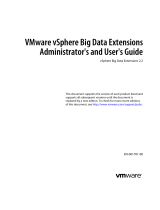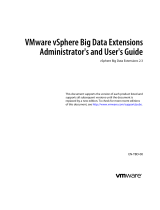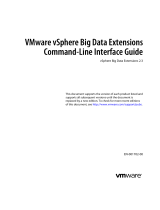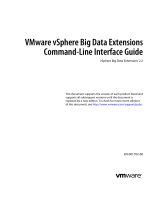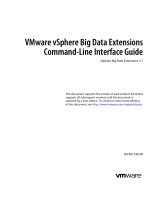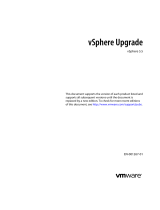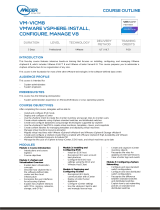Page is loading ...

VMware vSphere Big Data Extensions
Administrator's and User's Guide
vSphere Big Data Extensions 2.0
This document supports the version of each product listed and
supports all subsequent versions until the document is
replaced by a new edition. To check for more recent editions
of this document, see http://www.vmware.com/support/pubs.
EN-001514-02

VMware vSphere Big Data Extensions Administrator's and User's Guide
2 VMware, Inc.
You can find the most up-to-date technical documentation on the VMware Web site at:
http://www.vmware.com/support/
The VMware Web site also provides the latest product updates.
If you have comments about this documentation, submit your feedback to:
Copyright
©
2013, 2014 VMware, Inc. All rights reserved. Copyright and trademark information.
This work is licensed under a Creative Commons Attribution-NoDerivs 3.0 United States License
(http://creativecommons.org/licenses/by-nd/3.0/us/legalcode).
VMware, Inc.
3401 Hillview Ave.
Palo Alto, CA 94304
www.vmware.com

Contents
About This Book 7
Updated Information 9
1
About VMware vSphere Big Data Extensions 11
Getting Started with Big Data Extensions 11
Big Data Extensions and Project Serengeti 13
About Big Data Extensions Architecture 14
Big Data Extensions Support for Hadoop Features By Distribution 14
Hadoop Feature Support By Distribution 16
2
Installing Big Data Extensions 19
System Requirements for Big Data Extensions 20
Internationalization and Localization 22
Deploy the Big Data Extensions vApp in the vSphere Web Client 23
Install RPMs in the Serengeti Management Server Yum Repository 26
Install the Big Data Extensions Plug-In 27
Connect to a Serengeti Management Server 28
Install the Serengeti Remote Command-Line Interface Client 29
Access the Serengeti Command-Line Interface Using the Remote Command-Line Interface Client 30
3
Upgrading Big Data Extensions 33
Prepare to Upgrade Big Data Extensions 34
Upgrade Big Data Extensions Virtual Appliance 35
Upgrade the Big Data Extensions Plug-in 38
Upgrade the Serengeti Command-Line Interface 38
Upgrade the CentOS 6.x Template 39
Upgrade Big Data Extensions Virtual Machine Components 40
4
Managing Hadoop Distributions 43
Hadoop Distribution Deployment Types 43
Configure a Tarball-Deployed Hadoop Distribution 44
Configuring Yum and Yum Repositories 46
Create a Hadoop Template Virtual Machine using RHEL Server 6.x and VMware Tools 57
Maintain a Customized Hadoop Template Virtual Machine 60
5
Managing the Big Data Extensions Environment 63
Add Specific User Names to Connect to the Serengeti Management Server 64
Change the Password for the Serengeti Management Server 64
Configure vCenter Single Sign-On Settings for the Serengeti Management Server 65
Create a User Name and Password for the Serengeti Command-Line Interface 66
VMware, Inc.
3

Stop and Start Serengeti Services 66
6
Managing vSphere Resources for Hadoop and HBase Clusters 69
Add a Resource Pool with the Serengeti Command-Line Interface 70
Remove a Resource Pool with the Serengeti Command-Line Interface 70
Add a Datastore in the vSphere Web Client 70
Remove a Datastore in the vSphere Web Client 71
Add a Network in the vSphere Web Client 72
Reconfigure a Static IP Network in the vSphere Web Client 72
Remove a Network in the vSphere Web Client 73
7
Creating Hadoop and HBase Clusters 75
About Hadoop and HBase Cluster Deployment Types 76
About Cluster Topology 77
About HBase Database Access 77
Create a Hadoop or HBase Cluster in the vSphere Web Client 78
Create a Cluster with Topology Awareness with the Serengeti Command-Line Interface 80
8
Managing Hadoop and HBase Clusters 83
Stop and Start a Hadoop Cluster in the vSphere Web Client 84
Scale Out a Hadoop Cluster in the vSphere Web Client 84
Scale CPU and RAM in the vSphere Web Client 85
Reconfigure a Hadoop or HBase Cluster with the Serengeti Command-Line Interface 86
Delete a Hadoop Cluster in the vSphere Web Client 88
About Resource Usage and Elastic Scaling 88
Use Disk I/O Shares to Prioritize Cluster Virtual Machines in the vSphere Web Client 92
About vSphere High Availability and vSphere Fault Tolerance 93
Recover from Disk Failure with the Serengeti Command-Line Interface Client 93
Log in to Hadoop Nodes with the Serengeti Command-Line Interface Client 94
Change the User Password on All of a Cluster's Nodes 94
9
Monitoring the Big Data Extensions Environment 97
View Serengeti Management Server Initialization Status 97
View Provisioned Clusters in the vSphere Web Client 98
View Cluster Information in the vSphere Web Client 99
Monitor the Hadoop Distributed File System Status in the vSphere Web Client 100
Monitor MapReduce Status in the vSphere Web Client 101
Monitor HBase Status in the vSphere Web Client 101
10
Using Hadoop Clusters from the Serengeti Command-Line Interface 103
Run HDFS Commands with the Serengeti Command-Line Interface 103
Run MapReduce Jobs with the Serengeti Command-Line Interface 104
Run Pig and PigLatin Scripts with the Serengeti Command-Line Interface 104
Run Hive and Hive Query Language Scripts with the Serengeti Command-Line Interface 105
11
Accessing Hive Data with JDBC or ODBC 107
Configure Hive to Work with JDBC 107
Configure Hive to Work with ODBC 109
VMware vSphere Big Data Extensions Administrator's and User's Guide
4 VMware, Inc.

12
Troubleshooting 111
Log Files for Troubleshooting 112
Configure Serengeti Logging Levels 113
Collect Log Files for Troubleshooting 113
Big Data Extensions Virtual Appliance Upgrade Fails 114
Troubleshooting Cluster Creation Failures 114
Cannot Restart or Reconfigure a Cluster After Changing Its Distribution 121
Cannot Restart or Reconfigure a Cluster Whose Time Is Not Synchronized 121
Virtual Machine Cannot Get IP Address 122
vCenter Server Connections Fail to Log In 122
SSL Certificate Error When Connecting to Non-Serengeti Server with the vSphere Console 123
Serengeti Operations Fail After You Rename a Resource in vSphere 123
A New Plug-In Instance with the Same or Earlier Version Number as a Previous Plug-In Instance
Does Not Load 123
MapReduce Job Fails to Run and Does Not Appear In the Job History 124
Cannot Submit MapReduce Jobs for Compute-Only Clusters with External Isilon HDFS 125
MapReduce Job Stops Responding on a PHD or CDH4 YARN Cluster 125
Unable to Connect the Big Data Extensions Plug-In to the Serengeti Server 125
Cannot Perform Serengeti Operations after Deploying Big Data Extensions 126
Host Name and FQDN Do Not Match for Serengeti Management Server 127
Upgrade Cluster Error When Using Cluster Created in Earlier Version of Big Data Extensions 128
Index 129
Contents
VMware, Inc. 5

VMware vSphere Big Data Extensions Administrator's and User's Guide
6 VMware, Inc.

About This Book
VMware vSphere Big Data Extensions Administrator's and User's Guide describes how to install
Big Data Extensions within your vSphere environment, and how to manage and monitor Hadoop and
HBase clusters using the Big Data Extensions plug-in for vSphere Web Client.
VMware vSphere Big Data Extensions Administrator's and User's Guide also describes how to perform Hadoop
and HBase operations using the Serengeti Command-Line Interface Client, which provides a greater degree
of control for certain system management and Big Data cluster creation tasks.
Intended Audience
This guide is for system administrators and developers who want to use Big Data Extensions to deploy and
manage Hadoop clusters. To successfully work with Big Data Extensions, you should be familiar with
VMware
®
vSphere
®
and Hadoop and HBase deployment and operation.
VMware Technical Publications Glossary
VMware Technical Publications provides a glossary of terms that might be unfamiliar to you. For definitions
of terms as they are used in VMware technical documentation, go to
http://www.vmware.com/support/pubs.
VMware, Inc.
7

VMware vSphere Big Data Extensions Administrator's and User's Guide
8 VMware, Inc.

Updated Information
This VMware vSphere Big Data Extensions Administrator's and User's Guide is updated with each release of the
product or when necessary.
This table provides the update history of the VMware vSphere Big Data Extensions Administrator's and User's
Guide.
Revision Description
EN-001514-02 Enhanced the description of how to access the upgrade source in the topic “Download the Upgrade
Source and Accept the License Agreement,” on page 36.
EN-001514-01 Expanded the information on preparing to upgrade and upgrading the Big Data Extensions vApp in
Chapter 3, “Upgrading Big Data Extensions,” on page 33.
EN-001514-00 Initial release.
VMware, Inc. 9

VMware vSphere Big Data Extensions Administrator's and User's Guide
10 VMware, Inc.

About VMware vSphere Big Data
Extensions 1
VMware
®
vSphere™ Big Data Extensions lets you deploy and centrally operate Hadoop and HBase clusters
running on VMware vSphere. Big Data Extensions simplifies the Hadoop and HBase deployment and
provisioning process, and gives you a real time view of the running services and the status of their virtual
hosts. It provides a central place from which to manage and monitor your Hadoop and HBase cluster, and
incorporates a full range of tools to help you optimize cluster performance and utilization.
n
Getting Started with Big Data Extensions on page 11
VMware vSphere Big Data Extensions lets you deploy Hadoop and HBase clusters. The tasks in this
section describe how to set up vSphere for use with Big Data Extensions, deploy the Big Data
Extensions vApp, access the vCenter Server and command-line interface (CLI) administrative
consoles, and configure a Hadoop distribution for use with Big Data Extensions.
n
Big Data Extensions and Project Serengeti on page 13
Big Data Extensions runs on top of Project Serengeti, the open source project initiated by VMware to
automate the deployment and management of Hadoop and HBase clusters on virtual environments
such as vSphere.
n
About Big Data Extensions Architecture on page 14
The Serengeti Management Server and Hadoop Template virtual machine work together to configure
and provision Hadoop and HBase clusters.
n
Big Data Extensions Support for Hadoop Features By Distribution on page 14
Big Data Extensions provides different levels of feature support depending on the Hadoop
distribution and version that you use.
n
Hadoop Feature Support By Distribution on page 16
Each Hadoop distribution and version provides differing feature support. Learn which Hadoop
distributions support which features.
Getting Started with Big Data Extensions
VMware vSphere Big Data Extensions lets you deploy Hadoop and HBase clusters. The tasks in this section
describe how to set up vSphere for use with Big Data Extensions, deploy the Big Data Extensions vApp,
access the vCenter Server and command-line interface (CLI) administrative consoles, and configure a
Hadoop distribution for use with Big Data Extensions.
Prerequisites
n
Understand what Project Serengeti and Big Data Extensions is so that you know how they fit into your
Big Data workflow and vSphere environment. See “Big Data Extensions and Project Serengeti,” on
page 13.
VMware, Inc.
11

n
Verify that the Big Data Extensions features that you want to use, such as data-compute separated
clusters and elastic scaling, are supported by Big Data Extensions for the Hadoop distribution that you
want to use. See “Big Data Extensions Support for Hadoop Features By Distribution,” on page 14.
n
Understand which features are supported by your Hadoop distribution. See “Hadoop Feature Support
By Distribution,” on page 16.
Procedure
1 Do one of the following.
n
Install Big Data Extensions for the first time. Review the system requirements, install vSphere, and
install the Big Data Extensions components: Big Data Extensions vApp, Big Data Extensions plug-
in for vCenter Server, and Serengeti Remote Command-Line Interface Client. See Chapter 2,
“Installing Big Data Extensions,” on page 19.
n
Upgrade Big Data Extensions from a previous version. Perform the upgrade steps. See Chapter 3,
“Upgrading Big Data Extensions,” on page 33.
2 (Optional) Install and configure a distribution other than Apache Hadoop for use with Big Data
Extensions.
Apache Hadoop is included in the Serengeti Management Server, but you can use any Hadoop
distribution that Big Data Extensions supports. See Chapter 4, “Managing Hadoop Distributions,” on
page 43.
What to do next
After you have successfully installed and configured your Big Data Extensions environment, you can
perform the following additional tasks, in any order.
n
Stop and start the Serengeti services, create user accounts, manage passwords, and log in to cluster
nodes to perform troubleshooting. See Chapter 5, “Managing the Big Data Extensions Environment,” on
page 63.
n
Manage the vSphere resource pools, datastores, and networks that you use to create Hadoop and HBase
clusters. See Chapter 6, “Managing vSphere Resources for Hadoop and HBase Clusters,” on page 69.
n
Create, provision, and manage Hadoop and HBase clusters. See Chapter 7, “Creating Hadoop and
HBase Clusters,” on page 75 and Chapter 8, “Managing Hadoop and HBase Clusters,” on page 83.
n
Monitor the status of the clusters that you create, including their datastores, networks, and resource
pools, through the vSphere Web Client and the Serengeti Command-Line Interface. See Chapter 9,
“Monitoring the Big Data Extensions Environment,” on page 97.
n
On your Big Data clusters, run HDFS commands, Hive and Pig scripts, and MapReduce jobs, and access
Hive data. See Chapter 10, “Using Hadoop Clusters from the Serengeti Command-Line Interface,” on
page 103.
n
If you encounter any problems when using Big Data Extensions, see Chapter 12, “Troubleshooting,” on
page 111.
VMware vSphere Big Data Extensions Administrator's and User's Guide
12 VMware, Inc.

Big Data Extensions and Project Serengeti
Big Data Extensions runs on top of Project Serengeti, the open source project initiated by VMware to
automate the deployment and management of Hadoop and HBase clusters on virtual environments such as
vSphere.
Big Data Extensions and Project Serengeti provide the following components.
Project Serengeti
An open source project initiated by VMware, Project Serengeti lets users
deploy and manage Hadoop and Big Data clusters in a vCenter Server
managed environment. The major components are the Serengeti
Management Server, which provides cluster provisioning, software
configuration, and management services; an elastic scaling framework; and
command-line interface. Project Serengeti is made available under the
Apache 2.0 license, under which anyone can modify and redistribute Project
Serengeti according to the terms of the license.
Serengeti Management
Server
Provides the framework and services to run Big Data clusters on vSphere.
The Serengeti Management Server performs resource management, policy-
based virtual machine placement, cluster provisioning, software
configuration management, and environment monitoring.
Serengeti Command-
Line Interface Client
The command-line interface (CLI) client provides a comprehensive set of
tools and utilities with which to monitor and manage your Big Data
deployment. If you are using the open source version of Serengeti without
Big Data Extensions, the CLI is the only interface through which you can
perform administrative tasks.
Big Data Extensions
The commercial version of the open source Project Serengeti from VMware,
Big Data Extensions, is delivered as a vCenter Server Appliance.
Big Data Extensions includes all the Project Serengeti functions and the
following additional features and components.
n
Enterprise level support from VMware.
n
Hadoop distribution from the Apache community.
NOTE VMware provides the Hadoop distribution as a convenience but
does not provide enterprise-level support. The Apache Hadoop
distribution is supported by the open source community.
n
The Big Data Extensions plug-in, a graphical user interface integrated
with vSphere Web Client. This plug-in lets you perform common
Hadoop infrastructure and cluster management administrative tasks.
n
Elastic scaling lets you optimize cluster performance and utilization of
physical compute resources in a vSphere environment. Elasticity-
enabled clusters start and stop virtual machines, adjusting the number
of active compute nodes based on configuration settings that you
specify, to optimize resource consumption. Elasticity is ideal in a mixed
workload environment to ensure that workloads can efficiently share the
underlying physical resources while high-priority jobs are assigned
sufficient resources.
Chapter 1 About VMware vSphere Big Data Extensions
VMware, Inc. 13

About Big Data Extensions Architecture
The Serengeti Management Server and Hadoop Template virtual machine work together to configure and
provision Hadoop and HBase clusters.
Big Data Extensions performs the following steps to deploy a Hadoop or HBase cluster.
1 The Serengeti Management Server searches for ESXi hosts with sufficient resources to operate the
cluster based on the configuration settings that you specify, and then selects the ESXi hosts on which to
place Hadoop virtual machines.
2 The Serengeti Management Server sends a request to the vCenter Server to clone and configure virtual
machines to use with the Hadoop or HBase cluster.
3 The Serengeti Management Server configures the operating system and network parameters for the
new virtual machines.
4 Each virtual machine downloads the Hadoop software packages and installs them by applying the
distribution and installation information from the Serengeti Management Server.
5 The Serengeti Management Server configures the Hadoop parameters for the new virtual machines
based on the cluster configuration settings that you specify.
6 The Hadoop services are started on the new Hadoop virtual machines, at which point you have a
running cluster based on your configuration settings.
Big Data Extensions Support for Hadoop Features By Distribution
Big Data Extensions provides different levels of feature support depending on the Hadoop distribution and
version that you use.
Support for Hadoop MapReduce v1 Distribution Features
Big Data Extensions provides differing levels of feature support depending on the Hadoop distribution and
version that you configure for use. Table 1-1 lists the supported Hadoop MapReduce v1 distributions and
indicates which features are supported when using the distribution with Big Data Extensions.
Table 1‑1. Big Data Extensions Feature Support for Hadoop MapReduce v1 Distributions
Apache
Hadoop Cloudera Hortonworks Intel MapR
Version 1.2 CDH4, CDH5 HDP 1.3 2.5.1, 3.0.2 3.0.2-3.1.0
Automatic
Deployment
Yes Yes Yes Yes Yes
Scale Out Yes Yes Yes Yes Yes
Create Cluster
with Multiple
Networks
Yes Yes Yes Yes No
Data-Compute
Separation
Yes Yes Yes Yes Yes
Compute-only Yes Yes Yes Yes No
Elastic Scaling of
Compute Nodes
Yes Yes when
using
MapReduce
v1
Yes Yes No
Hadoop
Configuration
Yes Yes Yes Yes No
VMware vSphere Big Data Extensions Administrator's and User's Guide
14 VMware, Inc.

Table 1‑1. Big Data Extensions Feature Support for Hadoop MapReduce v1 Distributions (Continued)
Apache
Hadoop Cloudera Hortonworks Intel MapR
Hadoop Topology
Configuration
Yes Yes Yes Yes No
Run Hadoop
Commands from
the CLI
Yes No No No No
Hadoop
Virtualization
Extensions (HVE)
Yes No Yes No No
vSphere HA Yes Yes Yes Yes Yes
Service Level
vSphere HA
Yes See “About
Service Level
vSphere HA
for Cloudera,”
on page 16
Yes Yes No
vSphere FT Yes Yes Yes Yes Yes
Support for Hadoop MapReduce v2 (YARN) Distribution Features
Big Data Extensions provides differing levels of feature support depending on the Hadoop distribution and
version that you configure for use. Table 1-2lists the supported Hadoop MapReduce v2 distributions and
indicates which features are supported when using the distribution with Big Data Extensions.
Table 1‑2. Big Data Extensions Feature Support for Hadoop MapReduce v2 (YARN) Distributions
Apache
Bigtop
Apache
Hadoop Cloudera Cloudera Hortonworks Pivotal
Version 0.7.0 2.0 CDH4 CDH5 HDP 2.0, 2.1 PHD 1.1,
2.0
Automatic
Deployment
Yes Yes Yes Yes Yes Yes
Scale Out Yes Yes Yes Yes Yes Yes
Create
Cluster with
Multiple
Networks
Yes Yes Yes Yes Yes Yes
Data-
Compute
Separation
Yes Yes Yes Yes Yes Yes
Compute-
only
Yes Yes Yes Yes Yes Yes
Elastic
Scaling of
Compute
Nodes
Yes Yes No when
using
MapReduce
2
No when
using
MapReduce
2
Yes No
Hadoop
Configuratio
n
Yes Yes Yes Yes Yes Yes
Hadoop
Topology
Configuratio
n
Yes Yes Yes Yes Yes Yes
Chapter 1 About VMware vSphere Big Data Extensions
VMware, Inc. 15

Table 1‑2. Big Data Extensions Feature Support for Hadoop MapReduce v2 (YARN) Distributions
(Continued)
Apache
Bigtop
Apache
Hadoop Cloudera Cloudera Hortonworks Pivotal
Run Hadoop
Commands
from the CLI
No No No No No No
Hadoop
Virtualizatio
n Extensions
(HVE)
Support only
for HDFS
Support only
for HDFS
No Support
only for
HDFS
Support only
for HDFS.
HDP 1.3
provides full
support.
Yes
vSphere HA No No No No No No
Service Level
vSphere HA
No No See “About
Service Level
vSphere HA
for
Cloudera,”
on page 16
See “About
Service
Level
vSphere HA
for
Cloudera,”
on page 16
No No
vSphere FT No No No No No No
About Service Level vSphere HA for Cloudera
The Cloudera distributions offer the following support for Service Level vSphere HA.
n
Cloudera using MapReduce v1 provides service level vSphere HA support for JobTracker.
n
Cloudera provides its own service level HA support for NameNode through HDFS2.
Hadoop Feature Support By Distribution
Each Hadoop distribution and version provides differing feature support. Learn which Hadoop
distributions support which features.
Hadoop Features
The table illustrates which Hadoop distributions support which features.
Table 1‑3. Hadoop Feature Support
Apache
Hadoop
Apache
Bigtop Cloudera
Hortonwork
s Hortonworks Intel MapR Pivotal
Version 1.2 2.0 CDH4,
CDH5
HDP 1.3 HDP 2.0-2.1 2.5.1, 3.0.2 3.0.2-3.1.0 PHD 1.1,
2.0
HDFS1 Yes Yes No Yes Yes Yes No No
HDFS2 No Yes Yes No No No No Yes
MapReduce
v1
Yes Yes Yes Yes Yes Yes Yes No
MapReduce
v2 (YARN)
No Yes Yes No Yes No No Yes
Pig Yes Yes Yes Yes Yes Yes Yes Yes
Hive Yes Yes Yes Yes Yes Yes Yes Yes
Hive Server Yes Yes Yes Yes Yes Yes Yes Yes
VMware vSphere Big Data Extensions Administrator's and User's Guide
16 VMware, Inc.

Table 1‑3. Hadoop Feature Support (Continued)
Apache
Hadoop
Apache
Bigtop Cloudera
Hortonwork
s Hortonworks Intel MapR Pivotal
HBase Yes Yes Yes Yes Yes Yes Yes Yes
ZooKeeper Yes Yes Yes Yes Yes Yes Yes Yes
Chapter 1 About VMware vSphere Big Data Extensions
VMware, Inc. 17

VMware vSphere Big Data Extensions Administrator's and User's Guide
18 VMware, Inc.

Installing Big Data Extensions 2
To install Big Data Extensions so that you can create and provision Hadoop and HBase clusters, you must
install the Big Data Extensions components in the order described.
Procedure
1 System Requirements for Big Data Extensions on page 20
Before you begin the Big Data Extensions deployment tasks, your system must meet all of the
prerequisites for vSphere, clusters, networks, storage, hardware, and licensing.
2 Internationalization and Localization on page 22
Big Data Extensions supports internationalization (I18N) level 1. However, there are resources you
specify that do not provide UTF-8 support. You can use only ASCII attribute names consisting of
alphanumeric characters and underscores (_) for these resources.
3 Deploy the Big Data Extensions vApp in the vSphere Web Client on page 23
Deploying the Big Data Extensions vApp is the first step in getting your Hadoop cluster up and
running with vSphere Big Data Extensions.
4 Install RPMs in the Serengeti Management Server Yum Repository on page 26
Install the wsdl4j and mailx RPM packages within the Serengeti Management Server's internal Yum
repository.
5 Install the Big Data Extensions Plug-In on page 27
To enable the Big Data Extensions user interface for use with a vCenter Server Web Client, register the
plug-in with the vSphere Web Client. The Big Data Extensions graphical user interface is supported
only when using vSphere Web Client 5.1 and later. If you install Big Data Extensions on vSphere 5.0,
perform all administrative tasks using the Serengeti Command-Line Interface Client.
6 Connect to a Serengeti Management Server on page 28
To use the Big Data Extensions plug-in to manage and monitor Big Data clusters and Hadoop
distributions, you must connect the Big Data Extensions plug-in to the Serengeti Management Server
in your Big Data Extensions deployment.
7 Install the Serengeti Remote Command-Line Interface Client on page 29
Although the Big Data Extensions Plug-in for vSphere Web Client supports basic resource and cluster
management tasks, you can perform a greater number of the management tasks using the Serengeti
Command-line Interface Client.
8 Access the Serengeti Command-Line Interface Using the Remote Command-Line Interface Client on
page 30
You can access the Serengeti Command-Line Interface using the Serengeti Remote Command-Line
Interface Client. The Serengeti Remote Command-Line Interface Client lets you access the Serengeti
Management Server to deploy, manage, and use Hadoop.
VMware, Inc.
19

What to do next
If you want to create clusters on any Hadoop distribution other than Apache Hadoop, which is included in
the Serengeti Management Server, install and configure the distribution for use with Big Data Extensions.
See Chapter 4, “Managing Hadoop Distributions,” on page 43.
System Requirements for Big Data Extensions
Before you begin the Big Data Extensions deployment tasks, your system must meet all of the prerequisites
for vSphere, clusters, networks, storage, hardware, and licensing.
Big Data Extensions requires that you install and configure vSphere and that your environment meets
minimum resource requirements. Make sure that you have licenses for the VMware components of your
deployment.
vSphere Requirements
Before you install Big Data Extensions, set up the following VMware
products.
n
Install vSphere 5.0 (or later) Enterprise or Enterprise Plus.
NOTE The Big Data Extensions graphical user interface is supported
only when using vSphere Web Client 5.1 and later. If you install
Big Data Extensions on vSphere 5.0, perform all administrative tasks
using the Serengeti Command-Line Interface.
n
When installing Big Data Extensions on vSphere 5.1 or later, use
VMware
®
vCenter™ Single Sign-On to provide user authentication.
When logging in to vSphere 5.1 or later you pass authentication to the
vCenter Single Sign-On server, which you can configure with multiple
identity sources such as Active Directory and OpenLDAP. On successful
authentication, your user name and password is exchanged for a
security token that is used to access vSphere components such as
Big Data Extensions.
n
Configure all ESXi hosts to use the same Network Time Protocol (NTP)
server.
n
On each ESXi host, add the NTP server to the host configuration, and
from the host configuration's Startup Policy list, select Start and stop
with host. The NTP daemon ensures that time-dependent processes
occur in sync across hosts.
Cluster Settings
Configure your cluster with the following settings.
n
Enable vSphere HA and VMware vSphere
®
Distributed Resource
Scheduler™.
n
Enable Host Monitoring.
n
Enable Admission Control and set the policy you want. The default
policy is to tolerate one host failure.
n
Set the virtual machine restart priority to High.
n
Set the virtual machine monitoring to virtual machine and Application
Monitoring.
n
Set the Monitoring sensitivity to High.
n
Enable vMotion and Fault Tolerance Logging.
n
All hosts in the cluster have Hardware VT enabled in the BIOS.
VMware vSphere Big Data Extensions Administrator's and User's Guide
20 VMware, Inc.
/
